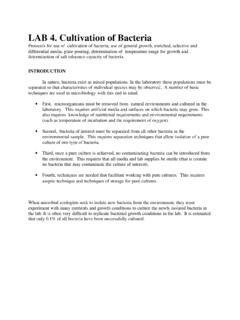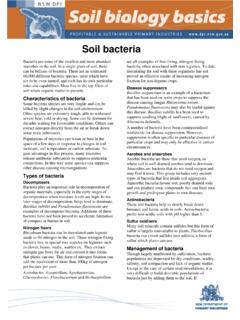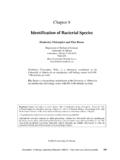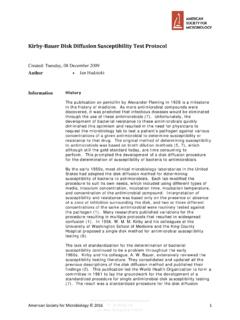Search results with tag "Of bacteria"
LAB 4. Cultivation of Bacteria - University of Maryland ...
science.umd.eduLAB 4. Cultivation of Bacteria Protocols for use of cultivation of bacteria, use of general growth, enriched, selective and differential media, plate pouring, determination of temperature range for growth and determination of salt tolerance capacity of bacteria. INTRODUCTION In nature, bacteria exist as mixed populations.
Isolation &Characterization of Bacteria
www.gbiosciences.comtechniques and cultivation of bacteria. Using theses bacterial culture techniques students discover and isolate the bacteria present around us. Following isolation of bacteria, students characterize the bacteria with household disinfectant products and antibiotics. Students learn and understand the significance of bacterial isolation in ...
Soil bacteria - Department of Primary Industries
www.dpi.nsw.gov.auSoil bacteria Bacteria are some of the smallest and most abundant microbes in the soil. In a single gram of soil, there can be billions of bacteria. There are an estimated 60,000 different bacteria species, most which have yet to be even named, and each has its own particular roles and capabilities. Most live in the top 10cm of
Chapter 10 - MICROBIOLOGICAL ANALYSES
www.who.intbacteria present which are counted, but the number of clumps of bacteria or the particles and their associated bacteria. Each clump or particle may have many bacteria associated with it. 10.1 Characteristics of indicator organisms Total coliforms The term “total coliforms” refers to a large group of Gram-negative, rod-shaped bacteria that
PURE CULTURE TECHNIQUES I. OBJECTIVES
www.sas.upenn.eduAlthough bacteria are ubiquitous in nature, beginning microbiology students are unaware of the extent of their presence. This lab will introduce you to a variety of different types of bacteria, the variation in types and numbers found in different habitats, and the physical conditions necessary for growth. You will take samples from a variety of
MORPHOLOGY AND Notes CLASSIFICATION OF BACTERIA
www.nios.ac.inTeichoic acids are found in the cell wall of Gram negative bacteria. The Outer membrane has Lipopolysaccharide channels with porins which transfer the solutes across. Lipoprotein cross link outer membrane and peptidoglycan layer Gram reaction may be related to the permeability of the bacterial cell wall and
Identification of Bacterial Species
www.ableweb.orgBacterial Identification 107 Flame this portion of the inoculating loop cap This also reduces the possibility of bacteria from your culture becoming airborne.
Kirby-Bauer Disk Diffusion Susceptibility Test Protocol
asm.orgresistance to that drug. The original method of determining susceptibility to antimicrobials was based on broth dilution methods (5, 7), which although still the gold standard today, are time consuming to perform. This prompted the development of a disk diffusion procedure for the determination of susceptibility of bacteria to antimicrobials.
Bacterial Culture & Growth - G-Biosciences
www.gbiosciences.comStudents can only see three phases of bacteria growth (lag, log and stationary) during one day culture. The bacteria growth will enter decline phase within 24 hours of culture. As the lysis of dead bacteria is slow, the absorbance of the total bacteria mass …








